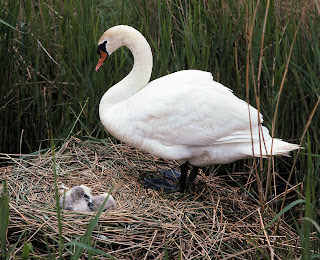Swan: Swans, genus Cygnus, are birds of the family Anatidae, which also includes geese and ducks. Swans are grouped with the closely related geese in the subfamily Anserinae where they form the tribe Cygnini. Sometimes, they are considered a distinct subfamily, Cygninae. There are six or seven species of swan in the genus Cygnus; in addition there is another species known as the Coscoroba Swan, although this species is no longer considered one of the true swans. Swans usually mate for life, though 'divorce' does sometimes occur, particularly following nesting failure. The number of eggs in each clutch ranges from three to eight.
The word swan is derived from Old English swan, akin to the German Schwan and Dutch zwaan and Swedish svan, in turn derived from Indo-European root *swen (to sound, to sing). Young swans are known as swanlings or as cygnets, from Greek κύκνος, kýknos and from the Latin word cygnus ("swan") and the Old French suffix -et ("little"). An adult male is a cob, from Middle English cobbe (leader of a group); an adult female is a pen. The swans are the largest members of the waterfowl family Anatidae, and are among the largest flying birds. The largest species, including the mute swan, trumpeter swan, and whooper swan, can reach length of over 1.5 m (60 inches) and weigh over 15 kg (33 pounds).
Swan
Swan
Swan
Swan




No comments:
Post a Comment